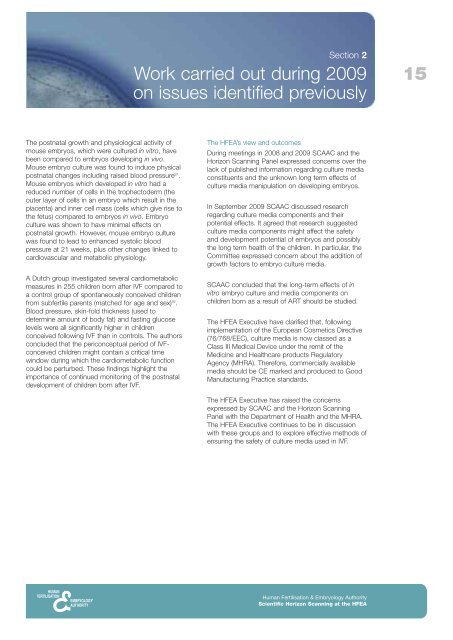Annual report 2009/10 - Human Fertilisation and Embryology Authority
Annual report 2009/10 - Human Fertilisation and Embryology Authority
Annual report 2009/10 - Human Fertilisation and Embryology Authority
You also want an ePaper? Increase the reach of your titles
YUMPU automatically turns print PDFs into web optimized ePapers that Google loves.
Section 2<br />
Work carried out during <strong>2009</strong><br />
on issues identified previously<br />
15<br />
The postnatal growth <strong>and</strong> physiological activity of<br />
mouse embryos, which were cultured in vitro, have<br />
been compared to embryos developing in vivo.<br />
Mouse embryo culture was found to induce physical<br />
postnatal changes including raised blood pressure 91 .<br />
Mouse embryos which developed in vitro had a<br />
reduced number of cells in the trophectoderm (the<br />
outer layer of cells in an embryo which result in the<br />
placenta) <strong>and</strong> inner cell mass (cells which give rise to<br />
the fetus) compared to embryos in vivo. Embryo<br />
culture was shown to have minimal effects on<br />
postnatal growth. However, mouse embryo culture<br />
was found to lead to enhanced systolic blood<br />
pressure at 21 weeks, plus other changes linked to<br />
cardiovascular <strong>and</strong> metabolic physiology.<br />
A Dutch group investigated several cardiometabolic<br />
measures in 255 children born after IVF compared to<br />
a control group of spontaneously conceived children<br />
from subfertile parents (matched for age <strong>and</strong> sex) 92 .<br />
Blood pressure, skin-fold thickness (used to<br />
determine amount of body fat) <strong>and</strong> fasting glucose<br />
levels were all significantly higher in children<br />
conceived following IVF than in controls. The authors<br />
concluded that the periconceptual period of IVFconceived<br />
children might contain a critical time<br />
window during which the cardiometabolic function<br />
could be perturbed. These findings highlight the<br />
importance of continued monitoring of the postnatal<br />
development of children born after IVF.<br />
The HFEA’s view <strong>and</strong> outcomes<br />
During meetings in 2008 <strong>and</strong> <strong>2009</strong> SCAAC <strong>and</strong> the<br />
Horizon Scanning Panel expressed concerns over the<br />
lack of published information regarding culture media<br />
constituents <strong>and</strong> the unknown long term effects of<br />
culture media manipulation on developing embryos.<br />
In September <strong>2009</strong> SCAAC discussed research<br />
regarding culture media components <strong>and</strong> their<br />
potential effects. It agreed that research suggested<br />
culture media components might affect the safety<br />
<strong>and</strong> development potential of embryos <strong>and</strong> possibly<br />
the long term health of the children. In particular, the<br />
Committee expressed concern about the addition of<br />
growth factors to embryo culture media.<br />
SCAAC concluded that the long-term effects of in<br />
vitro embryo culture <strong>and</strong> media components on<br />
children born as a result of ART should be studied.<br />
The HFEA Executive have clarified that, following<br />
implementation of the European Cosmetics Directive<br />
(76/768/EEC), culture media is now classed as a<br />
Class III Medical Device under the remit of the<br />
Medicine <strong>and</strong> Healthcare products Regulatory<br />
Agency (MHRA). Therefore, commercially available<br />
media should be CE marked <strong>and</strong> produced to Good<br />
Manufacturing Practice st<strong>and</strong>ards.<br />
The HFEA Executive has raised the concerns<br />
expressed by SCAAC <strong>and</strong> the Horizon Scanning<br />
Panel with the Department of Health <strong>and</strong> the MHRA.<br />
The HFEA Executive continues to be in discussion<br />
with these groups <strong>and</strong> to explore effective methods of<br />
ensuring the safety of culture media used in IVF.<br />
<strong>Human</strong> <strong>Fertilisation</strong> & <strong>Embryology</strong> <strong>Authority</strong><br />
Scientific Horizon Scanning at the HFEA

















